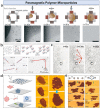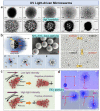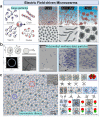Active Micro/Nanoparticles in Colloidal Microswarms
- PMID: 37242103
- PMCID: PMC10220621
- DOI: 10.3390/nano13101687
Active Micro/Nanoparticles in Colloidal Microswarms
Abstract
Colloidal microswarms have attracted increasing attention in the last decade due to their unique capabilities in various complex tasks. Thousands or even millions of tiny active agents are gathered with distinctive features and emerging behaviors, demonstrating fascinating equilibrium and non-equilibrium collective states. In recent studies, with the development of materials design, remote control strategies, and the understanding of pair interactions between building blocks, microswarms have shown advantages in manipulation and targeted delivery tasks with high adaptability and on-demand pattern transformation. This review focuses on the recent progress in active micro/nanoparticles (MNPs) in colloidal microswarms under the input of an external field, including the response of MNPs to external fields, MNP-MNP interactions, and MNP-environment interactions. A fundamental understanding of how building blocks behave in a collective system provides the foundation for designing microswarm systems with autonomy and intelligence, aiming for practical application in diverse environments. It is envisioned that colloidal microswarms will significantly impact active delivery and manipulation applications on small scales.
Keywords: active micro/nanoparticle; collective behavior; micro/nanorobot; microswarm; swarm control; wireless actuation.
Conflict of interest statement
The author declares no conflict of interest.
Figures









Similar articles
-
Probing Fast Transformation of Magnetic Colloidal Microswarms in Complex Fluids.ACS Nano. 2022 Nov 22;16(11):19025-19037. doi: 10.1021/acsnano.2c07948. Epub 2022 Nov 11. ACS Nano. 2022. PMID: 36367748
-
Domino Reaction Encoded Heterogeneous Colloidal Microswarm with On-Demand Morphological Adaptability.Adv Mater. 2021 Sep;33(37):e2100070. doi: 10.1002/adma.202100070. Epub 2021 Aug 1. Adv Mater. 2021. PMID: 34337789
-
External Power-Driven Microrobotic Swarm: From Fundamental Understanding to Imaging-Guided Delivery.ACS Nano. 2021 Jan 26;15(1):149-174. doi: 10.1021/acsnano.0c07753. Epub 2021 Jan 8. ACS Nano. 2021. PMID: 33417764 Review.
-
Mimicking the Structure and Function of Ant Bridges in a Reconfigurable Microswarm for Electronic Applications.ACS Nano. 2019 May 28;13(5):5999-6007. doi: 10.1021/acsnano.9b02139. Epub 2019 Apr 26. ACS Nano. 2019. PMID: 31013052
-
Collective Behaviors of Active Matter Learning from Natural Taxes Across Scales.Adv Mater. 2023 Feb;35(8):e2203959. doi: 10.1002/adma.202203959. Epub 2022 Dec 30. Adv Mater. 2023. PMID: 35986637 Review.
References
-
- Anderson C., Theraulaz G., Deneubourg J.L. Self-Assemblages in Insect Societies. Insectes Sociaux. 2002;49:99–110. doi: 10.1007/s00040-002-8286-y. - DOI
-
- Vicsek T., Zafeiris A. Collective Motion. Phys. Rep. 2012;517:71–140. doi: 10.1016/j.physrep.2012.03.004. - DOI
-
- Peleg O., Peters J.M., Salcedo M.K., Mahadevan L. Collective Mechanical Adaptation of Honeybee Swarms. Nat. Phys. 2018;14:1193–1198. doi: 10.1038/s41567-018-0262-1. - DOI
-
- Peeters C., De Greef S. Predation on Large Millipedes and Self-Assembling Chains in Leptogenys Ants from Cambodia. Insectes Sociaux. 2015;62:471–477. doi: 10.1007/s00040-015-0426-2. - DOI
Publication types
Grants and funding
- 52205590, 52202348/National Natural Science Foundation of China
- BK20220834/Natural Science Foundation of Jiangsu Province
- Fundamental Research Funds for the Central Universities
- 2023A1515011491/Guangdong Basic and Applied 289 Basic Research Foundation
- GXWD20220818224716001/Shenzhen Science and Technology Program
LinkOut - more resources
Full Text Sources

